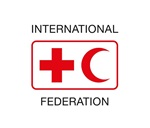Solar technology installed in water wells to provide renewable power to boreholes. The solar energy reduces the costs of extracting water.
The Kenya Red Cross Society pioneered solarisation of boreholes with funding support from European Commission Host Organization (ECHO). Oxfam drilled boreholes and equipped them with diesel generators and handed them over to the Kenya Red Cross Society. Pumps which use solar energy combined with diesel fuel were installed at six boreholes.
The solar powered pump supplies ~50 m3 of water daily. Solar panels have been installed on the roof of pumping stations. The water is pumped 130m below the ground into 20m high storage tanks. Water is then distributed via gravity to communal water stations. People living in camps can then fetch water from these stations and therefore have 24 hour access to water without the need for power.
Solar pumps reduce the cost of pumping water for camps by 30 per cent annually. Solar powered pumps in boreholes have now been adopted as best practice and replicated.
About 12,500 persons per borehole translating to 137,500 persons for 11 boreholes.
Design. [P1] Provides water more sustainably to refugees in the camp;
Programme. [P9] Responds to displaced populations in camps.
- Synchronizing the operating system of the generator and solar power. The change-over switch results in electrical faults with the online chlorination systems.
- Solar pumps reduce recurrent fuel costs and the maintenance cost of generators since they are engaged for less hours so save money.
- The borehole attendants need operational training.
Smart practices
Smart practices report and database survey
About the report
People migrate in pursuit of a better life for themselves and their families. As described in the International Federation of Red Cross and Red Crescent Societies’ (IFRC) Policy on Migration, “migrants are persons who leave or flee their habitual residence to go to new places – usually abroad – to seek opportunities or safer and better prospects.
Read more
About the International Federation

